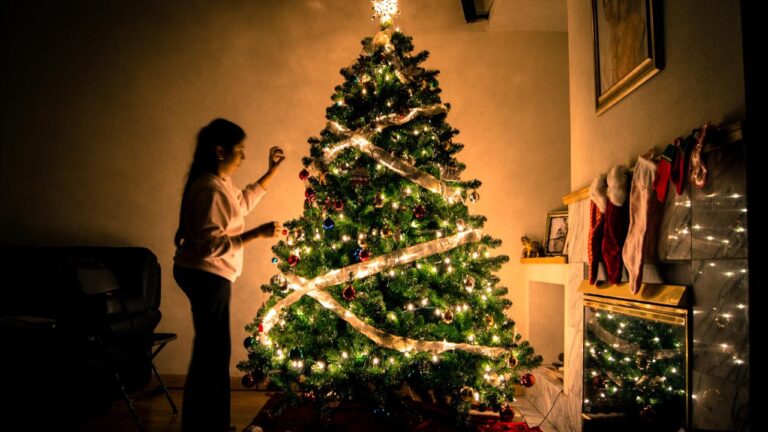When do you put up your Christmas tree? That’s the great debate of the Christmas season every year.
Do you like to have a tree up as soon as Halloween is over? Do you prefer to wait until the last moment and get the tree up the week before Christmas? Real, artificial, big, small, simple or loaded with ornaments, Canadian families have enjoyed their Christmas trees for centuries.
To tell the story of how Christmas trees came to be, we need to go back nearly 500 years.
Germans were the first people to begin decorating a tree for Christmas. Per National Geographic, the first recorded Christmas tree featuring lighted candles happened in 1539.
German Lutherans were the first to adopt this tradition. According to legend, they were inspired by Protestant Christian reformer Martin Luther.
He was walking home one evening when he was awestruck by the sight of stars twinkling between evergreens in a forest. This inspired him to put up a tree in his home, with lighted candles on the branches sometime in the early 1500s.
But there is no evidence that he was the first person to erect a Christmas tree with decorations beyond this story. What is confirmed is that Canada’s connection to Christmas trees is heavily tied to German history.
The first official Christmas tree in North America was put up on December 24, 1781, in Sorel, Quebec, at a party hosted by Baroness Frederika Charlotte Riedesel for British and German officers.
The previous few years had been a tough time for the baroness and her family. She had come to Canada with her husband and their infant daughters during the war.
Her husband fought for the British during the war, and he was captured after the Battle of Saratoga in 1777. He was not released until 1780.
During those dark years, the baroness saw men terribly injured in battle, many of whom she attended personally. She did what she could to help people, including providing food to troops, but it was a dark time in her life.
The Christmas of 1781 was the first time the baroness was able to celebrate Christmas in four years.
With better days now on the horizon, she hoped that she could brighten everyone’s mood with a Christmas tree.
After everyone had English pudding, she had a Balsam fir cut from the forest outside and put in the corner of the dining room.
It was decorated with fruits and lit with candles, making it the first official Christmas tree in North America.
The tradition of a Christmas tree didn’t entirely sweep the nation at this point. German immigrants to Canada did set up Christmas trees during the late 18th and early 19th centuries, but the tradition was slow to spread.
The upper class of Canada, for the most part, ignored the tradition until Queen Victoria and her German husband Prince Albert put up a tree in Windsor Castle in 1841.
The royal family was a trendsetter, and it became fashionable to have a tree in the UK, followed by the rest of the British Empire, including Canada.
By the mid-19th century, Christmas trees were on display in homes in many areas of Canada.
From the 1880s to the early 20th century, candles, natural fruits, and crafts were used to decorate Christmas trees.
In 1896, the first electrically lit Christmas tree was unveiled in Westmount, Quebec, 16 years after Thomas Edison introduced the first outdoor electric Christmas light display.
As the 20th century dawned, the use of the Christmas tree became more widespread across Canada. Christmas trees appeared at public entertainment events, bazaars and in hospitals. As more people became familiar with the Christmas tree, its popularity increased.
In 1930, the first artificial Christmas tree debuted, released by Addis Brush Company. These trees were cheaper in the long run, as one artificial tree could last a decade or more.
With the rise of mass media, including movies and television shows, Christmas trees grew exponentially in popularity. An example of this was It’s A Wonderful Life, a film released in 1946, which brought the image of the Christmas tree to millions of people.
Aluminum trees, which were silver and not green in colour, debuted in the mid-1950s and quickly rose in popularity for the next decade.
All that changed with one TV special.
A Charlie Brown Christmas, released in 1965, centred on the quest of beloved character Charlie Brown to find a real Christmas tree. The aluminum tree was seen as a symbol of commercialization in the special.
Almost overnight, the industry cratered, and by 1967, aluminum Christmas trees were collecting dust in attics or sitting in landfills.
It took until the late 20th century for the industry to recover from that major downturn.
While an artificial tree can be much easier to set up and take down, especially when LED lights are built directly into the branches, many people still prefer the feel and smell of a real tree, but the gap is closing.
In North America in 2016, people spent US$2 billion on natural trees and US$1.86 billion on artificial trees.
Christmas tree farms remain a big business in Canada. In 2021, 1,364 farms in Canada grew Christmas trees for sale, according to data from the Census of Agriculture.
These farms cover 50,803 acres, with Quebec leading the country at 19,169 acres. While Quebec has the most acres, it only has 257 Christmas tree farms. It sits third behind Ontario with 418 and British Columbia with 276.
Each year, Canada exports 2.4 million Christmas trees, 97.2% of which wind up in the US.
Today, you can find Christmas trees for sale at nearly every box store, outside grocery stores, in parking lots and more.
The holiday symbol we know and love today has found ubiquity because a baroness wanted to cheer everyone up after four long years of war and add a bit of festive cheer to the season.
Source:dailyhive
